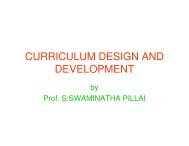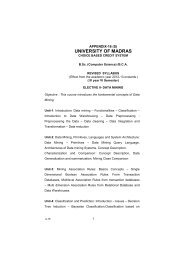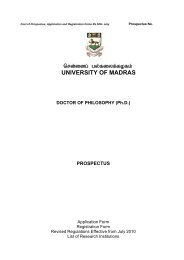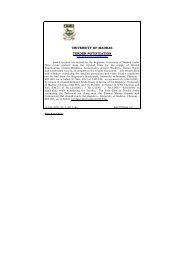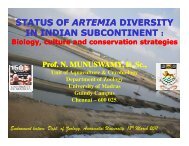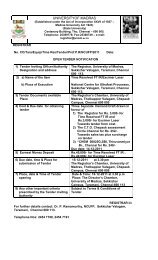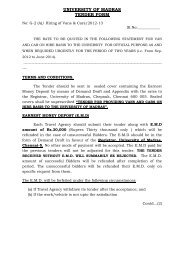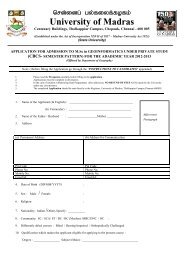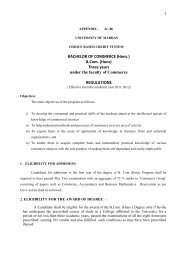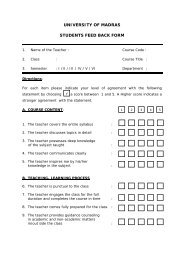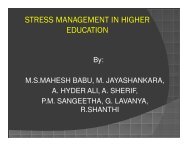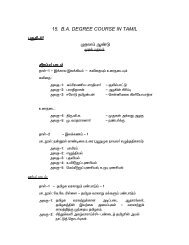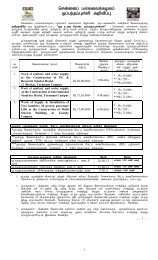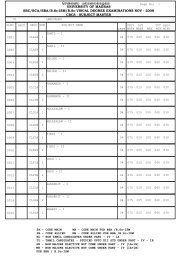Introduction of New Course in B.Sc. STATISTICS(CBCS)
Introduction of New Course in B.Sc. STATISTICS(CBCS)
Introduction of New Course in B.Sc. STATISTICS(CBCS)
You also want an ePaper? Increase the reach of your titles
YUMPU automatically turns print PDFs into web optimized ePapers that Google loves.
UNIVERSITY OF MADRAS<br />
BACHELOR DEGREE COURSE UNDER THE FACULTY OF SCIENCE (B.<strong>Sc</strong>)<br />
B.<strong>Sc</strong>. DEGREE COURSE IN <strong>STATISTICS</strong><br />
Choice Based Credit System<br />
REGULATIONS<br />
(w.e.f. 2011-2012)<br />
1. ELIGIBILITY FOR ADMISSION :<br />
Candidates for admission to B.<strong>Sc</strong>. Degree <strong>Course</strong> <strong>in</strong> Statistics shall be required<br />
to have passed the Higher Secondary Exam<strong>in</strong>ation (HSE),conducted by the Government<br />
<strong>of</strong> Tamil Nadu, or an exam<strong>in</strong>ation accepted as equivalent thereto by the Syndicate, with<br />
Mathematics or Statistics or Bus<strong>in</strong>ess Mathematics as a subject <strong>of</strong> study.<br />
2. ELIGIBILITY FOR THE AWARD OF DEGREE:<br />
A Candidate shall be eligible for the award <strong>of</strong> the Degree only if he/she has<br />
undergone the prescribed course <strong>of</strong> study <strong>in</strong> a college affiliated to the University for a<br />
period <strong>of</strong> not less than 3 academic years, passed the exam<strong>in</strong>ations all the Six-Semesters<br />
prescribed earn<strong>in</strong>g 140 Credits (<strong>in</strong> Parts-I, II, III, IV & V)<br />
3. DURATION<br />
a) Each academic year shall be divided <strong>in</strong>to two semesters. The first academic<br />
year shall comprise the first and second semesters, the second academic year<br />
the third and fourth semesters and the third academic year the fifth and sixth<br />
semester respectively.<br />
b) The odd semesters shall consist <strong>of</strong> the period from June to November <strong>of</strong><br />
each year and the even semesters from December to April <strong>of</strong> each year.<br />
There shall be not less than 90 work<strong>in</strong>g days for each semester.<br />
4. COURSE OF STUDY :<br />
The course <strong>of</strong> study for the B.<strong>Sc</strong>.Degree shall consist <strong>of</strong> the follow<strong>in</strong>g<br />
PART – I TAMIL / OTHER LANGUAGES<br />
PART – II<br />
ENGLISH<br />
1
PART – III<br />
CORE SUBJECTS<br />
ALLIED SUBJECTS<br />
PROJECT/ELECTIVES WITH THREE COURSES<br />
PART – IV<br />
1. (a) Those who have not studied Tamil up to XII Std. and taken a Non-<br />
Tamil Language under Part-I shall take Tamil compris<strong>in</strong>g <strong>of</strong> two<br />
course (level will be at 6 th Standard).<br />
(b)<br />
(c)<br />
Those who have studies Tamil up to XII Std. and taken a Non-Tamil<br />
Language under Part-I shall take Advanced Tamil compris<strong>in</strong>g <strong>of</strong> two<br />
courses.<br />
Others who do not come under a + b can choose non-major elective<br />
compris<strong>in</strong>g <strong>of</strong> two courses.<br />
2. SKILL BASED SUBJECTS (ELECTIVE) - (SOFT SKILLS)<br />
3. ENVIRONMENTAL STUDIES<br />
4 VALUE EDUCATION<br />
PART – V<br />
EXTENSION ACTIVITIES<br />
5. EXTENSION ACTIVITIES:<br />
A candidate shall be awarded a maximum <strong>of</strong> 1 Credit for Compulsory<br />
Extension Service.<br />
All the Students shall have to enroll for NSS /NCC/ NSO (Sports & Games)<br />
Rotract/ Youth Red cross or any other service organizations <strong>in</strong> the college and shall<br />
have to put <strong>in</strong> Compulsory m<strong>in</strong>imum attendance <strong>of</strong> 40 hours which shall be duly<br />
certified by the Pr<strong>in</strong>cipal <strong>of</strong> the college before 31 st March <strong>in</strong> a year. If a student<br />
LACKS 40 HOURS ATTENDANCE <strong>in</strong> the First year, he/she shall have to<br />
compensate the same dur<strong>in</strong>g the subsequent years.<br />
Students those who complete m<strong>in</strong>imum attendance <strong>of</strong> 40 hours <strong>in</strong> One year<br />
will get HALF A CREDIT and those who complete the attendance <strong>of</strong> 80 or more<br />
hours <strong>in</strong> Two Years will get ONE CREDIT.<br />
Literacy and population Education Field Work shall be compulsory<br />
components <strong>in</strong> the above extension service activities<br />
2
6. SCHEME OF EXAMINATIONS<br />
FIRST SEMESTER<br />
S.No Sem <strong>Course</strong> Paper Title<br />
Ins. Hours Maximum Marks Credits<br />
Components<br />
Theory Prac Int Ext Total<br />
1<br />
Language Language-Paper I 6 --- 25 75 100 3<br />
2 English English-Paper I 6 --- 25 75 100 3<br />
3 Core I Descriptive<br />
6 --- 25 75 100 4<br />
Statistics<br />
I Core III Practical-I --- 2 Practical exam<strong>in</strong>ation will be<br />
at the end <strong>of</strong> semester II<br />
4 Allied I Mathematics for 8 --- 25 75 100 5<br />
Statistics -I<br />
5 Non-Tamil<br />
Students:<br />
Tamil (VI<br />
Std)/Advanc<br />
ed Tamil/<br />
2 --- 100 2<br />
Tamil<br />
Students -<br />
Non-Major<br />
Elective I<br />
*Fundamentals <strong>of</strong><br />
Account<strong>in</strong>g<br />
S<strong>of</strong>t Skills 40 60 100 3<br />
SECOND SEMESTER<br />
S.No Sem <strong>Course</strong> Paper Title<br />
Ins. Hours Maximum Marks Credits<br />
Components<br />
Theory Prac Int Ext Total<br />
6<br />
Language Language-Paper II 6 --- 25 75 100 3<br />
7 English English-Paper II 6 --- 25 75 100 3<br />
8 Core II Probability and 6 --- 25 75 100 5<br />
II<br />
Random Variables<br />
9 Core III Practical-I --- 2 40 60 100 4<br />
10 Allied II Mathematics for 8 --- 25 75 100 5<br />
Statistics -II<br />
11 Non-Tamil<br />
Students:<br />
Tamil (VI<br />
Std)/Advanc<br />
ed Tamil/<br />
2 --- 100 2<br />
Tamil<br />
Students -<br />
Non-Major<br />
Elective II<br />
*Fundamentals <strong>of</strong><br />
Insurance<br />
S<strong>of</strong>t Skills 40 60 100 3<br />
* Syllabus for Non-major Elective I&II are available <strong>in</strong> Website : “www.unom.ac.<strong>in</strong>.”<br />
3
THIRD SEMESTER<br />
S.No Sem <strong>Course</strong> Paper Title<br />
Ins. Hours Maximum Marks Credits<br />
Components<br />
Theory Prac Int Ext Total<br />
12<br />
Language Language-Paper III 6 --- 25 75 100 3<br />
13 English English-Paper III 6 --- 25 75 100 3<br />
14 Core IV Distribution Theory 6 --- 25 75 100 4<br />
III Core VI Practical-II --- 2 Practical exam<strong>in</strong>ation will be<br />
at the end <strong>of</strong> semester IV<br />
15 Allied III ‘C’ Language 6 --- 25 75 100 4<br />
Programm<strong>in</strong>g<br />
Allied<br />
Practical<br />
‘C’ Language<br />
Programm<strong>in</strong>g<br />
--- 2 Practical exam<strong>in</strong>ation will be<br />
at the end <strong>of</strong> semester IV<br />
16 S<strong>of</strong>t Skills 2 40 60 100 3<br />
FOURTH SEMESTER<br />
S.No Sem <strong>Course</strong> Paper Title<br />
Ins. Hours Maximum Marks Credits<br />
Components<br />
Theory Prac Int Ext Total<br />
17 Language Language-Paper IV 6 --- 25 75 100 3<br />
18 English English-Paper IV 6 --- 25 75 100 3<br />
19 Core V Statistical Inference-I 6 --- 25 75 100 5<br />
20 Core VI Practical-II --- 2 40 60 100 4<br />
21 IV Allied IV Numerical Methods 6 --- 25 75 100 4<br />
22 Allied Numerical Methods<br />
2 40 60 100 2<br />
Practical and Practical <strong>in</strong> ‘C’<br />
S<strong>of</strong>t Skills 2 40 60 100 3<br />
Environmental Studies 25 75 100 2<br />
FIFTH SEMESTER<br />
23 Core VII Operations Research 5 --- 25 75 100 4<br />
24 Core VIII Statistical Inference-II 6 --- 25 75 100 5<br />
25 Core IX Sampl<strong>in</strong>g Theory 5 --- 25 75 100 4<br />
26 Core X Statistical Quality 5 --- 25 75 100 4<br />
V<br />
control<br />
27 Core Demography 6 --- 25 75 100 5<br />
Elective I<br />
28 Core XIV Practical-III 3 Practical exam<strong>in</strong>ation will be<br />
at the end <strong>of</strong> semester VI<br />
Value Education 100 2<br />
4
SIXTH SEMESTER<br />
29 Core XI Design <strong>of</strong> Experiments 5 --- 25 75 100 4<br />
30 Core XII Actuarial Statistics 6 --- 25 75 100 4<br />
31 Core XIII Time series, Index 6 --- 25 75 100 5<br />
Numbers and Official<br />
VI<br />
Statistics<br />
32 Core XIV Practical-III --- 3 40 60 100 4<br />
33 Core Stochastic Process 5 --- 25 75 100 5<br />
Elective II<br />
34 Core Managerial Economics 5 --- 25 75 100 5<br />
Elective III<br />
Extension Activities 1<br />
The follow<strong>in</strong>g procedure to be followed for Internal Marks:<br />
Theory Papers:<br />
Internal Marks 25<br />
Tests (2 out <strong>of</strong> 3 ) = 10<br />
Attendance = 5<br />
Sem<strong>in</strong>ars = 5<br />
Assignments = 5<br />
-----<br />
25 marks<br />
-----<br />
Break-up Details for Attendance<br />
Below 60% - No marks<br />
60% to 75% - 3 marks<br />
76% to 90 % - 4 marks<br />
91% to 100% - 5 marks<br />
Practical: Internal Marks 40<br />
Attendance<br />
Practical Test best 2 out <strong>of</strong> 3<br />
Record<br />
5 marks<br />
30 marks<br />
5 marks<br />
7. REQUIREMENTS FOR PROCEEDING TO SUBSEQUENT SEMESTER:<br />
i. Candidates shall register their names for the First Semester Exam<strong>in</strong>ation after<br />
the admission <strong>in</strong> UG <strong>Course</strong>s.<br />
5
ii. Candidates shall be permitted to proceed from the First Semester up to F<strong>in</strong>al<br />
Semester irrespective <strong>of</strong> their failure <strong>in</strong> any <strong>of</strong> the Semester Exam<strong>in</strong>ation<br />
subject to the condition that the candidates should register for all the arrear<br />
subject <strong>of</strong> earlier semesters along the current (subsequent) Semester Subjects.<br />
iii. Candidates shall be eligible to go to subsequent semester, only if they earn,<br />
sufficient attendance as prescribed therefor by the Syndicate from time to time.<br />
Provided <strong>in</strong> case <strong>of</strong> a candidate earn<strong>in</strong>g less than 50% <strong>of</strong> attendance <strong>in</strong> any one<br />
<strong>of</strong> the Semesters due to any extraord<strong>in</strong>ary circumstances such as medical<br />
grounds, such candidates who shall produce Medical Certificate issued by the<br />
Authorised Medical Attendant (AMA), duly certified by the Pr<strong>in</strong>cipal <strong>of</strong> the<br />
college, shall be permitted to proceed to the next semester and to complete the<br />
<strong>Course</strong> <strong>of</strong> study. Such Candidates shall have to repeat the missed Semester by<br />
rejo<strong>in</strong><strong>in</strong>g after completion <strong>of</strong> F<strong>in</strong>al Semester <strong>of</strong> the course, after pay<strong>in</strong>g the fee<br />
for the break <strong>of</strong> study as prescribed by the University from time to time.<br />
8. PASSING MINIMUM:<br />
A candidate shall be declared to have passed:<br />
a) There shall be no Pass<strong>in</strong>g M<strong>in</strong>imum for Internal.<br />
b) For External Exam<strong>in</strong>ation, Pass<strong>in</strong>g M<strong>in</strong>imum shall be <strong>of</strong> 40%(Forty<br />
Percentage) <strong>of</strong> the maximum marks prescribed for the paper for each<br />
Paper/Practical/Project and Viva-voce.<br />
c) In the aggregate (External + Internal) the pass<strong>in</strong>g m<strong>in</strong>imum shall be <strong>of</strong> 40% .<br />
d) He/She shall be declared to have passed the whole exam<strong>in</strong>ation, if he/she<br />
passes <strong>in</strong> all the papers and practicals wherever prescribed / as per the<br />
scheme <strong>of</strong> exam<strong>in</strong>ations by earn<strong>in</strong>g 140 CREDITS <strong>in</strong> Parts-I, II, III, IV & V.<br />
He/she shall also fulfill the extension activities prescribed earn<strong>in</strong>g a<br />
m<strong>in</strong>imum <strong>of</strong> 1 Credit to qualify for the Degree.<br />
9. CLASSIFICATION OF SUCCESSFUL CANDIDATES:<br />
PART- I TAMIL / OTHER LANGUAGES<br />
TAMIL/OTHER LANGUAGES: Successful candidates pass<strong>in</strong>g the<br />
Exam<strong>in</strong>ations for the Language and secur<strong>in</strong>g the marks (1) 60 percent and above<br />
and (ii) 50 percent and above but below 60 percent <strong>in</strong> the aggregate shall be<br />
declared to have passed the exam<strong>in</strong>ation <strong>in</strong> the FIRST and SECOND class,<br />
respectively. All other successful candidates shall be declared to have passed the<br />
exam<strong>in</strong>ation <strong>in</strong> the THIRD Class.<br />
PART – II ENGLISH<br />
ENGLISH: Successful candidates pass<strong>in</strong>g the exam<strong>in</strong>ations for English and<br />
secur<strong>in</strong>g the marks (i) 60 percent and above and (ii) 50 percent and above but<br />
below 60 percent <strong>in</strong> the aggregate shall be declared to have passed the exam<strong>in</strong>ation<br />
6
<strong>in</strong> the FIRST and SECOND Class, respectively. All other successful candidates<br />
shall be declared to have passed the exam<strong>in</strong>ation <strong>in</strong> the THIRD class.<br />
PART – III consist<strong>in</strong>g <strong>of</strong> CORE SUBJECTS, ALLIED SUBJECTS:<br />
Successful candidates pass<strong>in</strong>g the exam<strong>in</strong>ations for Core <strong>Course</strong>s<br />
together and secur<strong>in</strong>g the marks (i) 60 percent and above (ii) 50 percent and above<br />
but below 60 percent <strong>in</strong> the aggregate <strong>of</strong> the marks prescribed for the Core courses<br />
together shall be declared to have passed the exam<strong>in</strong>ation <strong>in</strong> the FIRST and<br />
SECOND Class respectively. All other successful candidates shall be declared to<br />
have passed the exam<strong>in</strong>ations <strong>in</strong> the Third Class.<br />
PART – IV (consist<strong>in</strong>g <strong>of</strong> sub items 1 (a), (b) & (c), 2, 3 and 4) as furnished <strong>in</strong><br />
the Regulations 4 Part-IV supra.<br />
PART – V EXTENSION ACTIVITIES:<br />
Successful Candidate earn<strong>in</strong>g <strong>of</strong> 1 credit SHALL NOT BE taken <strong>in</strong>to consideration<br />
for Classification/Rank<strong>in</strong>g/ Dist<strong>in</strong>ction.<br />
9a GRADING SYSTEM<br />
1. Pass<strong>in</strong>g M<strong>in</strong>imum is 40% <strong>of</strong> the ESE and also 40% <strong>of</strong> the maximum <strong>of</strong> that<br />
paper/course.<br />
2. M<strong>in</strong>imum Credits to be earned:<br />
For THREE year Programme: Best 140 Credits (Part I and II : Languages,<br />
Part III Major, Elective, Part –IV S<strong>of</strong>t skills and Part V :Extension activities)<br />
3. Marks and Grades:<br />
The follow<strong>in</strong>g table gives the marks, grade po<strong>in</strong>ts, letter grades and classification<br />
to <strong>in</strong>dicate the performance <strong>of</strong> the candidate.<br />
Conversion <strong>of</strong> Marks to Grade Po<strong>in</strong>ts and Letter Grade (Performance <strong>in</strong> a<br />
<strong>Course</strong> / Paper )<br />
RANGE OF GRADE LETTER DESCRIPTION<br />
MARKS POINTS GRADE<br />
90-100 9.0-10.0 O Outstand<strong>in</strong>g<br />
80-89 8.0-8.9 D+ Excellent<br />
75-79 7.5-7.9 D Dist<strong>in</strong>ction<br />
70-74 7.0-7.4 A+ Very Good<br />
60-69 6.0-6.9 A Good<br />
50-59 5.0-5.9 B Average<br />
40-49 4.0-4.9 C Satisfactory<br />
00-39 0.0 U Re-appear<br />
ABSENT 0.0 AAA ABSENT<br />
7
Ci = Credits earned for course<br />
i <strong>in</strong> any semester.<br />
Gi = Grade Po<strong>in</strong>t obta<strong>in</strong>ed for course i <strong>in</strong> any semester.<br />
n<br />
refers to the semester <strong>in</strong> which such courses were credited.<br />
For a Semester :<br />
GRADE POINT AVERAGE [GPA] = ∑i Ci Gi / ∑i Ci<br />
Sum <strong>of</strong> the multiplication <strong>of</strong> grade po<strong>in</strong>ts by the credits <strong>of</strong> the courses<br />
GPA = ----------------------------------------------------------------------------------<br />
Sum <strong>of</strong> the credits <strong>of</strong> the courses <strong>in</strong> a semester<br />
For the entire programme:<br />
CUMULATIVE GRADE POINT AVERAGE [CGPA] = ∑n∑i CniGni /∑n∑i Cni<br />
Sum <strong>of</strong> the multiplication <strong>of</strong> grade po<strong>in</strong>ts by the credits <strong>of</strong> the entire programme<br />
CGPA= -----------------------------------------------------------------------------------------------<br />
Sum <strong>of</strong> the credits <strong>of</strong> the courses <strong>of</strong> the entire programme<br />
CGPA GRADE CLASSIFICATION OF FINAL<br />
RESULT<br />
9.5-10.0 O+ First Class - Exemplary *<br />
9.0 and above but below 9.5 O<br />
8.5 and above but below 9.0 D++ First Class with Dist<strong>in</strong>ction *<br />
8.0 and above but below 8.5 D+<br />
7.5 and above but below 8.0 D<br />
7.0 and above but below 7.5 A++<br />
6.5 and above but below 7.0 A+<br />
6.0 and above but below 6.5 A<br />
First Class<br />
5.5 and above but below 6.0 B+ Second Class<br />
5.0 and above but below 5.5 B<br />
4.5 and above but below 5.0 C+ Third Class<br />
4.0 and above but below 4.5 C<br />
0.0 and above but below 4.0 U Re-appear<br />
* The candidates who have passed <strong>in</strong> the first appearance and with<strong>in</strong> the prescribed<br />
semester <strong>of</strong> the UG Programme (Major, Allied and Elective courses alone) are eligible.<br />
8
10. RANKING:<br />
Candidates who pass all the exam<strong>in</strong>ations prescribed for the course <strong>in</strong> the<br />
FIRST APPEARANCE ITSELF ALONE are eligible for Rank<strong>in</strong>g/ Dist<strong>in</strong>ction.<br />
Provided <strong>in</strong> the case <strong>of</strong> Candidates who pass all the exam<strong>in</strong>ations<br />
prescribed for the <strong>Course</strong> with a break <strong>in</strong> the First Appearance due to the reasons as<br />
furnished <strong>in</strong> the Regulations. 7 (iii) supra are only eligible for classification.<br />
11. QUESTION PAPER PATTERN<br />
SECTION – A ( 30 words)<br />
10 OUT OF 12 - 10 X 2 marks = 20 marks<br />
SECTION – B (200 words)<br />
5 out <strong>of</strong> 7 - 5 x 5 marks = 25 marks<br />
SECTION – C (500 words)<br />
3 out <strong>of</strong> 5 - 3x 10 marks = 30 marks<br />
--------------<br />
TOTAL = 75 marks<br />
--------------<br />
************<br />
9
UNIVERSITY OF MADRAS<br />
CHOICE BASED CREDIT SYSTEM<br />
B.<strong>Sc</strong>. DEGREE COURSE IN <strong>STATISTICS</strong><br />
SYLLABUS<br />
(w.e.f. 2011-2012 )<br />
Semester I<br />
Credits : 4<br />
Core Paper I Descriptive Statistics Hours: 6/week<br />
UNIT - 1:<br />
Nature and scope <strong>of</strong> statistical methods and their limitations - preparation <strong>of</strong><br />
questionnaire and schedule - Primary and Secondary sources <strong>of</strong> data - nom<strong>in</strong>al, ord<strong>in</strong>al,<br />
ratio and <strong>in</strong>terval scale - complete enumeration, controlled experiment, observational<br />
studies & sample surveys, Sources <strong>of</strong> secondary data <strong>in</strong>clud<strong>in</strong>g some Government<br />
publications.<br />
UNIT - 2:<br />
Presentation by tables and by diagrams- Construction <strong>of</strong> tables with one, two and<br />
three factors <strong>of</strong> classifications - Diagrammatic representations, frequency distributions for<br />
cont<strong>in</strong>uous and discrete data, graphical representation <strong>of</strong> a frequency distribution by<br />
histogram and frequency polygon, cumulative frequency distributions (<strong>in</strong>clusive and<br />
exclusive methods) and Ogives.<br />
UNIT - 3:<br />
Measures <strong>of</strong> location, dispersion, moments and measures <strong>of</strong> skewness and kurtosis for<br />
both grouped and ungrouped data.<br />
UNIT - 4:<br />
<strong>Sc</strong>atter diagram, regression l<strong>in</strong>es and concept <strong>of</strong> error <strong>in</strong> regression, pr<strong>in</strong>ciple <strong>of</strong> least<br />
squares and fitt<strong>in</strong>g <strong>of</strong> first, second degree and exponential curves, concept <strong>of</strong> correlation<br />
co-efficient and its properties. Spearman's rank correlation.Regression Equations.<br />
10
UNIT -5:<br />
Fundamental set <strong>of</strong> frequencies, Consistency <strong>of</strong> data, conditions for consistency,<br />
cont<strong>in</strong>gency table,association <strong>of</strong> attributes.<br />
Books for Study:<br />
Hogg, R.V. and Craig, A.T. (1998): <strong>Introduction</strong> to Mathematical Statistics, 4 th ed.<br />
Academic Press.<br />
Hoel, P.G. (1971): <strong>Introduction</strong> to Mathematical Statistics, Asia Publish<strong>in</strong>g House.<br />
Goon, AM., Gupta M.K and .Dasgupta B (1991): Fundamentals <strong>of</strong> Statistics, Vol.1,<br />
World Press, Calcutta.<br />
Bhat B.R, Srivenkataramana T, and Madhava K.S,(1996) Statistics: A Beg<strong>in</strong>ner's text<br />
Vol. I, <strong>New</strong> Age International (P) Ltd.<br />
Gupta,S.P.:Statistical methods,Sultan Chand & Sons Pvt Ltd.<strong>New</strong> Delhi.<br />
Books for Reference:<br />
G.U.Yule and M.G. Kendall (1956): An <strong>in</strong>troduction to the theory <strong>of</strong> Statistics, Charles<br />
Griff<strong>in</strong>.<br />
M.R. Spiegel (1961): Theory and problems <strong>of</strong> statistics, <strong>Sc</strong>haum's outl<strong>in</strong>e series.<br />
Snedecor .G.W. and Cochran W.G. (1967): Statistical methods, Iowa State University<br />
Press.<br />
Anderson, T.W. and <strong>Sc</strong>love SL. (1978): An <strong>in</strong>troduction to statistical analysis <strong>of</strong> data,<br />
Houghton Miff<strong>in</strong>/co.<br />
Croxton FE, and Cowden D.J. (1973) Applied General Statistics, Pr<strong>in</strong>tice Hall <strong>of</strong> India.<br />
Semester II<br />
Credits : 5<br />
Core Paper II - Probability and Random variables Hours: 6/week<br />
UNIT - 1:<br />
Random experiment, sample po<strong>in</strong>t, sample space, event, algebra <strong>of</strong> events, operations on<br />
events. Classical and relative frequency approach to probability - axiomatic approach to<br />
probability. Simple problems.<br />
11
UNIT –2 :<br />
Addition theorem <strong>of</strong> probability, conditional probability, <strong>in</strong>dependence <strong>of</strong> events<br />
multiplication theorem - Bayes theorem and its applications.<br />
UNIT –3:<br />
Def<strong>in</strong>ition <strong>of</strong> discrete and cont<strong>in</strong>uous random variables - probability mass function,<br />
distribution functions and probability density functions and their properties. Expectation<br />
<strong>of</strong> random variables and its properties.<br />
UNIT-4:<br />
Moment generat<strong>in</strong>g function, characteristic function, cumulant generat<strong>in</strong>g function - their<br />
properties, moments, measures <strong>of</strong> locations, dispersion, Skewness and Kurtosis for<br />
discrete and cont<strong>in</strong>uous variates.simple problems<br />
UNIT-5:<br />
Bivariate distributions - discrete and cont<strong>in</strong>uous type, cumulative distribution function<br />
(c,d.f.), and probability mass function (p.m.f) and probability density function (p.d.f.)<br />
Marg<strong>in</strong>al and Conditional expectation.<br />
Books for Study:<br />
A.M.Mood, F.A. Graybill and D.C. Boes (1974): <strong>Introduction</strong> to the theory <strong>of</strong> Statistics,<br />
International student ed. McGraw Hill.<br />
Hogg, R.V. and Craig, A.T. (1998): <strong>Introduction</strong> to Mathematical Statistics, 4 th ed.<br />
Academic Press.<br />
A.M.Goon, M.K.Gupta & B. Dasgupta (1980): An outl<strong>in</strong>e <strong>of</strong> Statistical theory, Vol. I, 6 th<br />
revised, World Press.<br />
Books For Reference:<br />
Rohatgi, V.K. (1984): An <strong>in</strong>troduction to probability theory and mathematical statistics.<br />
P.G.Hoel (1971): <strong>Introduction</strong> to Mathematical Statistics, Asia publish<strong>in</strong>g house.<br />
Murry R. Spiegal (1982): Theory and problems <strong>of</strong> Probability and Statistics, <strong>Sc</strong>haum's<br />
outl<strong>in</strong>e series, McGraw Hill.<br />
Seymour Lipshutz (1982): Theory and problems <strong>of</strong> probability, <strong>Sc</strong>haum's outl<strong>in</strong>e series,<br />
McGraw Hill.<br />
Marek Fisz (1961): Probability theory and Mathematical Statistics, John Wiley.<br />
12
K.L.Chung (1983): Elementary probability theory with stochastic processes, Spr<strong>in</strong>ger<br />
International student edition.<br />
William.Feller (1968): An <strong>in</strong>troduction to probability theory and its applications, Vol. I,<br />
3 rd ed., John Wiley & Sons.<br />
Semester III<br />
Credits :4<br />
Core Paper IV Distribution Theory Hours:6/week<br />
UNIT -1:<br />
Discrete distributions : B<strong>in</strong>omial, Tr<strong>in</strong>omial and Mult<strong>in</strong>omial distributions and their<br />
properties - Poisson, Negative B<strong>in</strong>omial and Geometric distributions and their properties.<br />
UNIT -2:<br />
Cont<strong>in</strong>uous distributions : Normal, Uniform, Exponential, Gamma and Beta<br />
distributions and their properties.<br />
UNIT -3:<br />
Bivariate Normal Distribution and its properties. Partial and multiple correlation and<br />
regression – Concepts and simple problems.<br />
UNIT -4:<br />
Basic Central Limit Theorem (statement only) - Limit<strong>in</strong>g distributions : Poisson<br />
distribution as a limit<strong>in</strong>g case <strong>of</strong> B<strong>in</strong>omial - Poisson distribution as a limit<strong>in</strong>g case <strong>of</strong><br />
Negative B<strong>in</strong>omial distribution - Convergence <strong>of</strong> B<strong>in</strong>omial, Poisson, Gamma and Chisquare<br />
distribution to Normal distribution us<strong>in</strong>g Moment generat<strong>in</strong>g function.<br />
UNIT-5:<br />
Order statistics-distribution <strong>of</strong> first,n th and i th order statistics,jo<strong>in</strong>t distribution <strong>of</strong> r th and s th<br />
order statistics-distribution <strong>of</strong> median and range.Simple problems.<br />
Books for Study :<br />
1. Gupta, S. C and Kapoor, V. K (2002), Fundamentals <strong>of</strong> Mathematical Statistics,<br />
Sultan Chand and Sons, <strong>New</strong> Delhi.<br />
13
Books for Reference :<br />
2. Hogg, R. V and Craig, A. T (2002), <strong>Introduction</strong> to Mathematical Statistics, Pearson<br />
Education Asia, India.<br />
Semester IV<br />
Credits : 5<br />
Core Paper V Statistical Inference – I Hours : 5/week<br />
UNIT - 1:<br />
Sampl<strong>in</strong>g distributions - concept - distributions <strong>of</strong> mean and variance from Normal<br />
population. Sampl<strong>in</strong>g distributions : Chi-square, Student’s t and F distributions -<br />
Derivation <strong>of</strong> their density functions and their properties<br />
UNIT - 2:<br />
Po<strong>in</strong>t Estimation - Problem <strong>of</strong> Po<strong>in</strong>t estimation - Properties <strong>of</strong> estimators- Consistency<br />
and Efficiency <strong>of</strong> an estimator. Sufficiency <strong>of</strong> a statistic - Neyman- Fisher factorization<br />
theorem (discrete case) - Simple problems.<br />
UNIT - 3:<br />
Unbiasedness - Properties, MVUE, BLUE, Rao - Blackwell theorem-Sufficiency and<br />
completeness, Lehman- <strong>Sc</strong>heffe theorem, Cramer- Rao <strong>in</strong>equality - simple problems.<br />
UNIT - 4:<br />
Methods <strong>of</strong> estimation: Method <strong>of</strong> Moments, Method <strong>of</strong> Maximum Likelihood, Method<br />
<strong>of</strong> m<strong>in</strong>imum chi-square, Method <strong>of</strong> modified m<strong>in</strong>imum chi-square, method <strong>of</strong> least<br />
squares- properties <strong>of</strong> estimators obta<strong>in</strong>ed by these methods -simple problems.<br />
UNIT - 5:<br />
Interval Estimation - Confidence Interval for proportions, mean(s), variance, and variance<br />
ratio based on chi square, student's t, F and Normal distributions. Tests <strong>of</strong> significance:<br />
concepts - tests based on normal, t, F, and Chi Square.<br />
Books for Study:<br />
Mood, AM. Graybill , F.A. and Boes, D.C. (1974) : <strong>Introduction</strong> to the theory <strong>of</strong><br />
Statistics, McGraw Hill.<br />
14
Hogg R.V. and Craig, A.T. (1972): <strong>Introduction</strong> to mathematical statistics, 3 rd edition,<br />
Academic Press, USA.<br />
Goon, A.M. Gupta, M.K., and Das Gupta, B. (1980): An outl<strong>in</strong>e <strong>of</strong> statistical theory,<br />
Vol.I, 6 th revised ed. World Press limited, Calcutta.<br />
Books For Reference:<br />
Hoel, P.G. (1971) : <strong>Introduction</strong> to mathematical Statistics, Asia publish<strong>in</strong>g house.<br />
Rohatgi, V.K. (1984) An <strong>in</strong>troduction to probability theory and mathematical statistics,<br />
Wiley Eastern.<br />
Degroot, M.H. (1975): Probability and Statistics, Addison - Wesley<br />
Marek Fisz (1961): Probability theory and Mathematical statistics, John Wiley.<br />
Spiegal, M.R. (1982): Theory and problems <strong>of</strong> probability and statistics, <strong>Sc</strong>haum's outl<strong>in</strong>e<br />
series, McGraw Hill<br />
Snedecor, G.W. and Cochran, W.G. (1967): Statistical methods 6 th edition, Oxford IBH<br />
Publish<strong>in</strong>g Co.<br />
Wilks, S.S. (1962): Mathematical statistics - John Wiley & Sons.<br />
Semester V<br />
Credits : 4<br />
Core Paper VII Operations Research Hours: 5/week<br />
UNIT - 1:<br />
<strong>Introduction</strong> to OR, Nature ,<strong>Sc</strong>ope, Functions , L<strong>in</strong>ear programm<strong>in</strong>g problem -<br />
Formulation <strong>of</strong> LPP - Solv<strong>in</strong>g the LPP by graphical method.<br />
UNIT - 2:<br />
Solv<strong>in</strong>g the LPP by simplex method ,Big-M method, Duality <strong>in</strong> LPP, Dual simplex<br />
method.<br />
UNIT - 3:<br />
Transportation problem- obta<strong>in</strong><strong>in</strong>g <strong>in</strong>itial, feasible and optimal solutions. Optimality test<br />
degeneracy, Unbalanced transportation problem, Assignment problem, and unbalanced<br />
assignment problem - Travel<strong>in</strong>g salesman problem.<br />
15
UNIT - 4:<br />
Game Theory - Two person zero sum games, The maxim<strong>in</strong> - m<strong>in</strong>imax pr<strong>in</strong>ciple - Games<br />
without saddle po<strong>in</strong>ts - Mixed strategies - Graphical solution <strong>of</strong> 2xn and mx2 games<br />
Dom<strong>in</strong>ance property. Sequenc<strong>in</strong>g - 'n' jobs through 2 mach<strong>in</strong>es - 'n' jobs through 3<br />
mach<strong>in</strong>es - 'n' jobs through ‘m’ mach<strong>in</strong>es, Two jobs and 'm' mach<strong>in</strong>es.<br />
UNIT - 5:<br />
Network analysis by CPM / PERT basic concepts - constra<strong>in</strong>ts <strong>in</strong> Network - construction<br />
<strong>of</strong> the network - Time calculations - Concepts <strong>of</strong> slack and float <strong>in</strong> Network Analysis -<br />
f<strong>in</strong>d<strong>in</strong>g optimum project duration and m<strong>in</strong>imum project cost, f<strong>in</strong>d<strong>in</strong>g expected project<br />
time and variance.<br />
Books For Study And Reference:<br />
Handy A. Taha (1996): Operations Research, 6 ed. Prentice Hall <strong>of</strong> India<br />
Kanti Swamp et al: Operations Research, suichand and Sons, <strong>New</strong> Delhi.<br />
Goel & Mittal (1982): Operations Research, Pragati Prakashan, Meerut.<br />
Gupta R.K.(1985): Operations Research, Krishna Prakashan, Mandir, Meerut.<br />
<strong>Sc</strong>haum's outl<strong>in</strong>e series : Operations Research.<br />
Frederick S.Hillier & Gerald J.Lieberman: (1987) Operations Research, CBS publishers<br />
& Distributors, Delhi.<br />
Sharma J.K. (2001): Operations Research. Theory and applications, Macmillan India Ltd.<br />
Sharma J.K. (2002): Operations Research. Problems and solutions, Macmillan India Ltd.<br />
Credits : 5<br />
Core Paper VIII Statistical Inference – II Hours : 6/week<br />
UNIT – 1:<br />
Test<strong>in</strong>g <strong>of</strong> Hypothesis - Neyman - Pearson theory - Statistical Hypothesis - Simple and<br />
composite hypothesis, Null and Alternative Hypothesis - Two types <strong>of</strong> errors - critical<br />
region- powers <strong>of</strong> a test - Most powerful test – Neyman-Pearson lemma - simple<br />
problems<br />
16
UNIT - 2:<br />
Uniformly most powerful tests, Likelihood ratio criterion - Def<strong>in</strong>ition and test for means<br />
and variance (one sample only).<br />
UNIT - 3:<br />
Sequential Probability Ratio Test: Def<strong>in</strong>ition - properties and simple problems.<br />
UNIT - 4:<br />
Non-parametric tests - Run, Median, sign and Mann Whitney tests (one sample and two<br />
sample) problems. Wilcoxon Signed rank test, test sum test, Kolmogorov's Smirnov one<br />
sample test, and Kruskal Wallis test.<br />
UNIT - 5:<br />
Basic ideas on decision theory - Loss functions - Risk functions - Prior distributions -<br />
Bayes Risk - Simple problems based on Bayes estimation and test<strong>in</strong>g.<br />
Books for Study and Reference:<br />
Mood, A.M. Graybill, F.A. and Boes, D.C. (1974): <strong>Introduction</strong> to the theory <strong>of</strong><br />
Statistics, McGraw Hill.<br />
Hogg R.V.and Craig, A.T. (1972): <strong>Introduction</strong> to mathematical statistics, 3 rd edition,<br />
Academic Press, USA.<br />
Goon, A.M. Gupta, M.K., and Das Gupta, B. (1980): An outl<strong>in</strong>e <strong>of</strong> statistical theory,<br />
Vol.I, 6 th revised ed. World Press limited, Calcutta.<br />
Hod, P.G. (1971): <strong>Introduction</strong> to mathematical statistics, Asia publish<strong>in</strong>g house.<br />
Rohatgi, V.K. (1984) An <strong>in</strong>troduction to probability theory and mathematical statistics,<br />
Wiley Eastern.<br />
Marek Fisz (1961): Probability theory and Mathematical statistics, John Wiley.<br />
Spiegal,M.R. (1982): Theory and problems <strong>of</strong> probability and statistics, <strong>Sc</strong>haum's outl<strong>in</strong>e<br />
series, McGraw Hill<br />
Snedecor, G.W. and Cochran, W.G. (1967): Statistical methods 6 th edition<br />
17
UNIT - 1:<br />
Credits : 4<br />
Core Paper IX Sampl<strong>in</strong>g Theory Hours : 5/week<br />
Design - Organization and execution <strong>of</strong> sample surveys - pr<strong>in</strong>ciple steps <strong>in</strong> sample survey<br />
- Pilot survey - pr<strong>in</strong>ciples <strong>of</strong> sample survey - sampl<strong>in</strong>g and non-sampl<strong>in</strong>g errors -<br />
advantages <strong>of</strong> sampl<strong>in</strong>g over complete census - limitations <strong>of</strong> sampl<strong>in</strong>g.<br />
UNIT - 2:<br />
Sampl<strong>in</strong>g from f<strong>in</strong>ite population - simple random sampl<strong>in</strong>g with and Without<br />
replacement - unbiased estimate <strong>of</strong> the mean, variance <strong>of</strong> the estimate <strong>of</strong> the mean f<strong>in</strong>ite<br />
population correction estimation <strong>of</strong> standard error from a sample - determ<strong>in</strong>ation <strong>of</strong><br />
sample size.<br />
UNIT - 3:<br />
Stratified random sampl<strong>in</strong>g - properties <strong>of</strong> the estimates - unbiased estimates <strong>of</strong> the mean<br />
and variance <strong>of</strong> the estimates <strong>of</strong> the mean-optimum and proportional allocations - relative<br />
precision <strong>of</strong> a stratified sampl<strong>in</strong>g and simple random sampl<strong>in</strong>g - estimation <strong>of</strong> ga<strong>in</strong> <strong>in</strong><br />
precision <strong>in</strong> stratified sampl<strong>in</strong>g.<br />
UNIT - 4:<br />
Systematic sampl<strong>in</strong>g - estimate <strong>of</strong> mean and variance <strong>of</strong> the estimated mean - comparison<br />
<strong>of</strong> simple and stratified with systematic random sampl<strong>in</strong>g.<br />
UNIT - 5:<br />
Ratio estimators: Ratio estimates, variance <strong>of</strong> the ratio estimates - Bias <strong>of</strong> the ratio<br />
estimates. Regression estimators: L<strong>in</strong>ear regression estimate regression estimates with<br />
pre assigned b-regression estimates when b is computed from the sample.<br />
Books for Study:<br />
William, G. Cochran (1984): Sampl<strong>in</strong>g techniques, Wiley Eastern.<br />
Books For Reference:<br />
Des Raj (1976): Sampl<strong>in</strong>g theory, Tata McGraw Hill,<br />
Daroga S<strong>in</strong>gh & Chaudhary, F.S. (1986): Theory and Analysis <strong>of</strong> Sample Survey<br />
Designs. Wiley Eastern.<br />
Sukhatme P.V. et al (1984): Sample survey methods and its applications, Indian Society<br />
<strong>of</strong> Agricultural Statistics, <strong>New</strong> Delhi.<br />
Murthy, M.N. (1967): Sampl<strong>in</strong>g theory and methods, Statistical Publish<strong>in</strong>g Society,<br />
Calcutta.<br />
Sampath S. (1999): Sampl<strong>in</strong>g theory and methods. <strong>New</strong> Age International Ltd.<br />
Eng<strong>in</strong>eer<strong>in</strong>g Updates<br />
Kapoor, V.K. and Gupta, S.P. (1978): Fundamentals <strong>of</strong> applied statistics, Sultan Chand &<br />
Sons.<br />
18
UNIT -1:<br />
Credits : 4<br />
Core Paper X Statistical Quality Control Hours : 5/week<br />
Need for Statistical Quality Control techniques <strong>in</strong> Industry - Causes <strong>of</strong> Quality variation<br />
control charts - Use <strong>of</strong> the Shewhart - control chart - Specification and tolerance limits - 3<br />
sigma limits - warn<strong>in</strong>g limits - application <strong>of</strong> theory <strong>of</strong> runs <strong>in</strong> quality control.<br />
UNIT - 2:<br />
Control chart for variables - X chart ,R chart,σ chart - purpose <strong>of</strong> the charts - Basis <strong>of</strong> sub<br />
group<strong>in</strong>g - plott<strong>in</strong>g X and R results - determ<strong>in</strong><strong>in</strong>g the trial control limits - Interpretation <strong>of</strong><br />
control charts X and R.<br />
UNIT - 3:<br />
Control chart for attributes - purpose <strong>of</strong> the chart - p chart - np chart - construction <strong>of</strong> p<br />
and np chart - choice between chart for P and chart for np - construction <strong>of</strong> c-chart.<br />
UNIT - 4:<br />
Acceptance <strong>of</strong> sampl<strong>in</strong>g plans for attributes - Producer's risk and consumer's risk -<br />
concepts <strong>of</strong> AQL, LTPD, AOQ, AOQL, ATI and ASN - s<strong>in</strong>gle, double and Multiples<br />
sampl<strong>in</strong>g plans - OC, AOQ, ATI curves for s<strong>in</strong>gle and Double sampl<strong>in</strong>g plans.<br />
UNIT - 5:<br />
Variable sampl<strong>in</strong>g plans - Sigma known and sigma unknown determ<strong>in</strong>ation <strong>of</strong> n and k for<br />
one sided specification - OC curve.<br />
Books for Study:<br />
Kapoor, V.K. and Gupta, S.P. (1978): Fundamentals <strong>of</strong> applied statistics, Sultan Chand &<br />
Sons.<br />
Gupta, R.C.(1974): Statistical Quality Control.<br />
Montgomery, D.C. (1983): <strong>Introduction</strong> to Statistical Quality Control, John Waley &<br />
Sons.<br />
Ekambaram, S K. (1963): Statistical basis <strong>of</strong> Acceptance sampl<strong>in</strong>g, Asia Publish<strong>in</strong>g<br />
House.<br />
Books For Reference:<br />
Grant, E,L. and Laven Worth, R.S.: Statistical Quality Control, McGraw Hill.<br />
19
Semester VI<br />
UNIT - 1:<br />
Credits :4<br />
Core Paper XI Design <strong>of</strong> Experiments Hours : 5/week<br />
Fundamental Pr<strong>in</strong>ciples <strong>of</strong> Experiments - Replication, Randomization and Local Control<br />
Techniques - Size <strong>of</strong> experimental unit-Methods <strong>of</strong> determ<strong>in</strong>ation <strong>of</strong> experimental units -<br />
(Maximum curvature method-Fairfield Smith's variance law).<br />
UNIT - 2:<br />
Analysis <strong>of</strong> Variance - one-way, two-way classification (without <strong>in</strong>teraction) Multiple<br />
range tests: <strong>New</strong>man Keul's test- Duncan's multiple range test. Tukey's test-<br />
Transformations Squrare root, angular and log transformations.<br />
UNIT - 3:<br />
L<strong>in</strong>ear Model and its classifications. Completely Randomized Design (CRD) and its<br />
analysis-Randomized Block Design (RBD) and its analysis-Lat<strong>in</strong> Square Design(LSD)<br />
and its analysis.<br />
UNIT - 4:<br />
Miss<strong>in</strong>g plot technique-Mean<strong>in</strong>g-Least square method <strong>of</strong> estimat<strong>in</strong>g miss<strong>in</strong>g<br />
Observations- and two observations miss<strong>in</strong>g <strong>in</strong> RBD and LSD - Analysis <strong>of</strong> covariance<br />
technique <strong>in</strong> CRD and RBD(without derivation)<br />
UNIT - 5:<br />
Factorial experiments - Def<strong>in</strong>ition 2 2 , 2 3 and 3 2 factorial experiments and their analysis -<br />
Pr<strong>in</strong>ciples <strong>of</strong> confound<strong>in</strong>g-Partial and Complete confound<strong>in</strong>g <strong>in</strong> 2 3 - Split plot design and<br />
its analysis, BlBD concept and parametric Relations.<br />
Books for Study:<br />
Dass M.N and G<strong>in</strong> N.C (1986) Design and Analysis <strong>of</strong> Experiments, Wiley<br />
Eastern, <strong>New</strong> Delhi.<br />
Kempthorne, (1956) Design and Analysis <strong>of</strong> Experiments, John Wiley. <strong>New</strong> York.<br />
Books For Reference:<br />
Montgomery, D (1972) Design <strong>of</strong> Experiments, John Wiley and Sons<br />
Kapoor, V.K. and Gupta, S.P. (1978): Fundamentals <strong>of</strong> applied statistics, Sultan Chand &<br />
Sons.<br />
20
Credits : 4<br />
Core Paper XII Actuarial Statistics Hours : 6/week<br />
UNIT – 1:<br />
Elements <strong>of</strong> compound <strong>in</strong>terest-nom<strong>in</strong>al and Effective rates <strong>of</strong> <strong>in</strong>terest, annuities<br />
certa<strong>in</strong>, present values accumulated amounts, deferred annuities – the functions <strong>in</strong>cluded<br />
<strong>in</strong> compound <strong>in</strong>terest - tables and their uses<br />
UNIT – 2:<br />
Redemption <strong>of</strong> loans – s<strong>in</strong>k<strong>in</strong>g funds – the average yield on the life fund <strong>of</strong> an<br />
assurance <strong>of</strong>fice<br />
UNIT – 3:<br />
Premiums – general pr<strong>in</strong>ciples – natural premiums – level premiums – <strong>of</strong>fice<br />
premiums – load<strong>in</strong>g for expenses – with pr<strong>of</strong>it and without pr<strong>of</strong>it premiums – adequacy<br />
<strong>of</strong> premiums relative consistency<br />
UNIT – 4:<br />
Life <strong>of</strong>fice valuations – general pr<strong>in</strong>ciples – policy values – retrospective and<br />
prospective methods <strong>of</strong> valuation <strong>of</strong> liabilities<br />
UNIT – 5:<br />
Surplus - Sources <strong>of</strong> Surplus, Pr<strong>in</strong>ciple methods <strong>of</strong> surplus (Numerical problems<br />
can be asked <strong>in</strong> the theory question paper).<br />
Books for Study:<br />
1. Federation <strong>of</strong> Insurance Institutes Study <strong>Course</strong>s – Mathematical Basis <strong>of</strong> Life<br />
Assurances F1, 2<br />
2. Donald. D. W . (1970) – Compound Interest and Annuities, He<strong>in</strong>emann, London<br />
Books for Reference:<br />
1. Elandt – Johnson. R.C, Johnson. N.L (1980), Survival Models and Data Analysis,<br />
John Wiley.<br />
21
Credits :5<br />
Hours :6/week<br />
Core Paper XIII<br />
Time Series, Index Numbers and Official Statistics<br />
UNIT - 1:<br />
Time series - Concept - Components <strong>of</strong> time Series - Additive and multiplicative models<br />
- Measurement <strong>of</strong> trend – free hand method-semi average method-Mov<strong>in</strong>g average<br />
method - Least square method.<br />
UNIT - 2:<br />
Measurement <strong>of</strong> seasonal variations - Simple average method - Ratio to trend method -<br />
Ratio to mov<strong>in</strong>g average method - L<strong>in</strong>k relative method - Variate Difference method.<br />
UNIT - 3:<br />
Index Numbers - uses, classification <strong>of</strong> <strong>in</strong>dex numbers - Problems <strong>in</strong> the construction <strong>of</strong><br />
<strong>in</strong>dex numbers - Methods <strong>of</strong> construct<strong>in</strong>g <strong>in</strong>dex numbers - Unweighted <strong>in</strong>dex numbers -<br />
weighted <strong>in</strong>dex numbers.<br />
UNIT - 4:<br />
Quantity <strong>in</strong>dex numbers - Fixed and cha<strong>in</strong> base <strong>in</strong>dex numbers - Optimum test for <strong>in</strong>dex<br />
numbers - Time reversal test - factor reversal test - cost <strong>of</strong> liv<strong>in</strong>g <strong>in</strong>dex numbers.<br />
UNIT - 5:<br />
Official Statistics: Statistical System <strong>in</strong> India CSO and NSSO and its functions - Present<br />
structure <strong>of</strong> the Indian statistical system - Functions <strong>of</strong> a statistical system - Agricultural<br />
statistics - Industrial statistics - Trade statistics - Labour statistics - transport and<br />
Communication statistics.<br />
Books for Study:<br />
Kapoor,V.K and Gupta,S.C (1978); Fundamentals <strong>of</strong> Applied Statistics, Sultan chand &<br />
Sons.<br />
Saluja,M.R (1972): Indian <strong>of</strong>ficial statistical systems: Statistical publish<strong>in</strong>g society,<br />
Calcutta and The Indian Econometric Society, Hyderabad.<br />
Books For Reference:<br />
Gupta, S.P (1999): Statistical Methods, Sultan & Sons, <strong>New</strong> Delhi.<br />
Croxton, F.E & Cowdon, D.J. (1973): Applied general statistics, Prentice Hall<br />
22
Credits : 4<br />
Core Paper III Practical I Hours : 2/week for<br />
Semesters I and II<br />
(Based on core paper I)<br />
NOTE :<br />
Record 40 Marks, Practical Exam<strong>in</strong>ation 60 Marks<br />
Duration <strong>of</strong> the Exam<strong>in</strong>ation : Three Hours.<br />
Six questions are to be set without omitt<strong>in</strong>g any unit.<br />
Candidates are to answer any four questions.<br />
All questions carry equal marks.<br />
1.Construction <strong>of</strong> Uni-variate,bi-variate frequency distributions,<br />
2.Diagrammatic and graphical representations.<br />
3.Ogives,Lorenz curves,<br />
4.Measures <strong>of</strong> location, dispersion<br />
5. measures <strong>of</strong> skewness and kurtosis for both grouped and ungrouped data.<br />
6. measures <strong>of</strong> skewness and kurtosis us<strong>in</strong>g moments.<br />
7.pr<strong>in</strong>ciple <strong>of</strong> least squares and fitt<strong>in</strong>g <strong>of</strong> first, second degree and exponential curves.<br />
8.Computation <strong>of</strong> correlation co-efficient.<br />
9.Rank correlation.<br />
10.Regression Equations.<br />
11Construction <strong>of</strong> cont<strong>in</strong>gency table.<br />
12.Association <strong>of</strong> Attributes.<br />
23
Credits : 4<br />
Core Paper VI Practical II Hours : 2/week<br />
Semesters III and IV<br />
(Based on core paper IV & V )<br />
1. Fitt<strong>in</strong>g <strong>of</strong> B<strong>in</strong>omial Distribution.<br />
2. Fitt<strong>in</strong>g <strong>of</strong> Poission Distribution.<br />
3. Fitt<strong>in</strong>g <strong>of</strong> Normal Distribution.<br />
4. Estimation <strong>of</strong> parameters by the methods <strong>of</strong> Moments.<br />
5. Estimation <strong>of</strong> parameters by the methods <strong>of</strong> MLE.<br />
6. Test <strong>of</strong> Hypothesis :<br />
Power <strong>of</strong> the test ,level <strong>of</strong> significance.<br />
7.Test <strong>of</strong> significance<br />
i. Mean and variance.<br />
ii. Difference <strong>of</strong> means.<br />
iii. Equality <strong>of</strong> two variances from normal distribution<br />
iv. Test <strong>of</strong> significance <strong>of</strong> correlation coefficients<br />
8.Confidence <strong>in</strong>terval for mean,variance.<br />
9.Partial and Multiple Correlation.<br />
10. Partial and Multiple Regression.<br />
24
Credits : 4<br />
Core Paper XIV Practical III Hours :3 /week<br />
Semesters V and VI<br />
(Based on core paper IX,X,XI & XIII )<br />
1. Non-parametric methods :<br />
a. Sign test<br />
b. Signed rank test<br />
b. Median test<br />
c. Mann Whitney U-test<br />
d. Test <strong>of</strong> randomness <strong>of</strong> sample.<br />
2.Simple Random Sampl<strong>in</strong>g.<br />
3.Stratified Random Sampl<strong>in</strong>g- Proportional Allocation<br />
4. Stratified Random Sampl<strong>in</strong>g- Optimum Allocation<br />
5,Systematic Sampl<strong>in</strong>g.<br />
6.X Chart ,R Chart,σ chart.<br />
7.p,np and c chart.<br />
8. Analysis <strong>of</strong> Variance - one-way and two-way.<br />
9.Design <strong>of</strong> Experiment –CRD.<br />
10.Design <strong>of</strong> Experiment-RBD.<br />
11.Design <strong>of</strong> Experiment-LSD.<br />
12. Miss<strong>in</strong>g plot technique- one miss<strong>in</strong>g frequency.<br />
13.Factorial experiments – 2 2 , 2 3 , 3 2 experiments with total and partial confound<strong>in</strong>g.<br />
14. Mov<strong>in</strong>g average method, Least square method<br />
15 Ratio to trend method, Ratio to mov<strong>in</strong>g average method, L<strong>in</strong>k relative method.<br />
16.Fixed and cha<strong>in</strong> base <strong>in</strong>dex numbers, Optimum test for <strong>in</strong>dex numbers<br />
17.Time reversal test ,factor reversal test , cost <strong>of</strong> liv<strong>in</strong>g <strong>in</strong>dex numbers.<br />
25
Semester V<br />
Core Elective Paper I Credits :5<br />
Demography<br />
Hours :6/week<br />
UNIT - 1:<br />
Sources <strong>of</strong> Demographic data – Civil Registration- Population Census –<br />
Population Registers – Errors <strong>in</strong> Demographic data – Methods <strong>of</strong> Improvement.<br />
UNIT – 2:<br />
Mortality measurements –Merits and Demerits - general and specific rates –<br />
standardized rates – age pyramid <strong>of</strong> sex composition – Ratios, propositions and<br />
percentage rates – Population pyramids, sex ratio, crude rate, specific rates, standard rates<br />
– direct and <strong>in</strong>direct.<br />
UNIT -3:<br />
Fertility, Measures <strong>of</strong> fertility, General fertility rate, Specific fertility rate, Net<br />
reproduction rate, Gross reproduction rate, Crude Rate <strong>of</strong> natural <strong>in</strong>crease. Def<strong>in</strong>ition –<br />
stable population and stationery population.<br />
UNIT - 4:<br />
Life table - Structure - Construction – Relationship between function <strong>of</strong> the life<br />
table – abridged life table (Concept only)<br />
UNIT – 5:<br />
Population estimation and projection, component method <strong>of</strong> population projection<br />
Forces <strong>of</strong> mortality - Gompertz and Makcham law logistic curve fitt<strong>in</strong>g and its use.<br />
Books for Study and Reference:<br />
1. Srivastava, O.S (1983): A text book Demography, Vikas Publish<strong>in</strong>g<br />
2. Bogue, Donald, . J: Pr<strong>in</strong>ciples <strong>of</strong> Demography, (1976), John Wiley, <strong>New</strong> York.<br />
26
Semester VI<br />
Core Elective Paper II Credits :5<br />
Stochastic Process<br />
Hours :5/week<br />
UNIT - 1:<br />
Basic Concepts : Def<strong>in</strong>ition and examples <strong>of</strong> stochastic process, classification <strong>of</strong> general<br />
stochastic processes <strong>in</strong>to discrete and cont<strong>in</strong>uous time, discrete and cont<strong>in</strong>uous state<br />
spaces, types <strong>of</strong> stochastic processes, elementary problems.<br />
UNIT - 2:<br />
Markov cha<strong>in</strong>s : Def<strong>in</strong>ition and examples <strong>of</strong> Markov cha<strong>in</strong>, Transition Probability<br />
Matrix, classification <strong>of</strong> states, recurrence, simple problems<br />
UNIT - 3:<br />
Basic limit theorem <strong>of</strong> Markov cha<strong>in</strong> (statement only), stationary probability distribution,<br />
applications.<br />
UNIT - 4:<br />
Cont<strong>in</strong>uous Time Markov cha<strong>in</strong> : Pure birth process and Poisson process, Birth and Death<br />
process, problems.<br />
UNIT - 5:<br />
Branch<strong>in</strong>g process : Def<strong>in</strong>ition and examples <strong>of</strong> discrete time branch<strong>in</strong>g process,<br />
probability generat<strong>in</strong>g function, mean and variance, probability <strong>of</strong> ext<strong>in</strong>ction,simple<br />
problems.<br />
Books For Study and Reference:<br />
Karl<strong>in</strong>, S. and Taylor, H.M. (1975): A first course <strong>in</strong> Stochastic processes, Academic<br />
press.<br />
Hoel, P.M.G., Port, S.C. and Stone, C.J. (1991): <strong>Introduction</strong> to Stochastic processes,<br />
Universal Book Stall.<br />
Parzen, E. (1962): Stochastic processes, Holden-Day.<br />
C<strong>in</strong>lar, B. (1975) <strong>Introduction</strong> to Stochastic processes, Prentice Hall.<br />
Adke, S.R. and Manjunath, S.M. (1984): An <strong>in</strong>troduction to F<strong>in</strong>ite Markov Processes,<br />
Wiley Eastern.<br />
Medhi, J. (1996): Stochastic processes, <strong>New</strong> Age International (p) Ltd.<br />
Ross, S.M. (1983): Stochastic processes, John Wiley.<br />
Taylor, H.M. and Karl<strong>in</strong>, S. (1999): Stochastic Modell<strong>in</strong>g, Academic press.<br />
27
Core Elective Paper III Credits :5<br />
Unit 1:<br />
Managerial Economics<br />
Hours :5/week<br />
<strong>Sc</strong>ope and methods <strong>of</strong> Managerial Economics – Laws <strong>of</strong> demand , Demand schedule<br />
(Individual and Market) - Demand function - Factors <strong>in</strong>fluenc<strong>in</strong>g the demand -<br />
Exception to the law <strong>of</strong> demand – Elasticity <strong>of</strong> demand with respect to price and <strong>in</strong>come -<br />
Factors affect<strong>in</strong>g the elasticity <strong>of</strong> demand - Partial elasticity <strong>of</strong> demand with respect to<br />
price - Simple problems <strong>in</strong> elasticity <strong>of</strong> demand.<br />
Unit 2:<br />
Supply - Factors affect<strong>in</strong>g the supply <strong>of</strong> a commodity - Relation between demand and<br />
supply – Utility - Concept <strong>of</strong> utility - Concept <strong>of</strong> human wants - Maximization <strong>of</strong> utility -<br />
Marg<strong>in</strong>al and total utility - Law <strong>of</strong> dim<strong>in</strong>ish<strong>in</strong>g marg<strong>in</strong>al utility - Indifference curves and<br />
map - Properties <strong>of</strong> <strong>in</strong>difference curve - Price l<strong>in</strong>e.<br />
Unit 3:<br />
Cost Analysis – Different types <strong>of</strong> cost - Total, average and marg<strong>in</strong>al cost functions -<br />
Relation between average and marg<strong>in</strong>al costs - Problems related to total, average and<br />
marg<strong>in</strong>al costs – Revenue - Total, average and marg<strong>in</strong>al revenue functions and their<br />
relationship - Simple problems related to maximization <strong>of</strong> total revenue<br />
Unit 4:<br />
Market Structure – Def<strong>in</strong>ition <strong>of</strong> Market - Perfect completion - Pure competition -<br />
Monopolistic competition and duopolistic competition (Only concept) - Pr<strong>of</strong>it<br />
maximization – Pr<strong>of</strong>it function - Cournot solution to monopoly problem for<br />
maximization problem - Jo<strong>in</strong>t monopoly and discrim<strong>in</strong>at<strong>in</strong>g monopoly - Problems related<br />
to pr<strong>of</strong>it maximization under monopoly. Duopoly - Conjectural variation and reaction<br />
curves - Simple maximization problem under duopoly.<br />
28
Unit 5:<br />
Theoretical Production functions – Mathematical def<strong>in</strong>ition <strong>of</strong> production function -<br />
Constant product curves (Isoquant) - Average and marg<strong>in</strong>al productivity - Homogenous<br />
production functions – Properties <strong>of</strong> l<strong>in</strong>early homogeneous production function – Cobb-<br />
Douglas production function – C. E. S. production function.<br />
Books for Study :<br />
Varma and Agarwal (1998): Managerial Economics, Sultan Chand and Company, <strong>New</strong><br />
Delhi.<br />
Mehta and Madhnani (2001): Mathematics for Economists, Sultan Chand and Company,<br />
<strong>New</strong> Delhi (Chapters 6, 8, and 9).<br />
Dr.S. Shankarn<br />
Varshney and maheswari<br />
K.P.M.Sundaram<br />
Managerial Economics<br />
Managerial Economics<br />
Busniess Economics<br />
Semester I<br />
Allied Paper I Credits : 5<br />
Mathematics for Statistics – I<br />
Hours : 8/week<br />
UNIT – 1:<br />
Matrix theory-def<strong>in</strong>ition and type <strong>of</strong> matrices, scalar, Elementary, Symmetric,<br />
Skew Symmetric, Hermitian, Skew-Hermitian, <strong>in</strong>dependent and unitary matrices-algebric<br />
operations on matrices and their properties-elementary transformations <strong>of</strong> matrices -<br />
determ<strong>in</strong>ant <strong>of</strong> matrix, def<strong>in</strong>ition <strong>of</strong> a row rank – column rank and rank <strong>of</strong> a matrix -<br />
determ<strong>in</strong>ation <strong>of</strong> rank <strong>of</strong> a matrix.<br />
UNIT – 2:<br />
Inverse <strong>of</strong> a square matrix – computation <strong>of</strong> the <strong>in</strong>verse <strong>of</strong> the square matrix -<br />
solution <strong>of</strong> l<strong>in</strong>ear equations – Homogenous and non-homogenous systems <strong>of</strong> equations –<br />
solutions space – consistency and general solutions Cramer’s Rule and matrix methods <strong>of</strong><br />
solv<strong>in</strong>g system equations and numerical examples, characteristic equations – root and<br />
vectors <strong>of</strong> a square matrix – left and right eigen vectors – Cayley – Hamilton theorem -<br />
quadratic forms, def<strong>in</strong>ite, semi def<strong>in</strong>ite and <strong>in</strong>def<strong>in</strong>ite quadratic forms,<br />
Sylvester’s law <strong>of</strong> <strong>in</strong>ertia.<br />
29
UNIT – 3:<br />
Logarithmic differentiation – Differentiation <strong>of</strong> one function with respect to<br />
another function – differentiation from parametric equations – Differentiation <strong>of</strong> implicit<br />
functions- Increas<strong>in</strong>g and decreas<strong>in</strong>g functions.<br />
UNIT – 4:<br />
Successive differentiation – Leibnitz theorem – Partial Differentiation – Maxima<br />
and M<strong>in</strong>ima <strong>of</strong> functions <strong>of</strong> two variables.<br />
UNIT – 5:<br />
Integration – Properties <strong>of</strong> def<strong>in</strong>ite <strong>in</strong>tegrals – Reduction formula – Bernoulli’s<br />
formula.<br />
Books for study and reference:<br />
1. Narayanan and T. K. Manickavachagam Pillai (1996): Calculus (Vol I & II)<br />
S.V. Publications.<br />
2. Shanti Narayanan: Differential and Integral Calculus, Chand & Co.<br />
Semester II<br />
Allied Paper II Credits : 5<br />
UNIT – 1:<br />
Mathematics for Statistics – II<br />
Hours: 8/week<br />
Sets, Operations on sets – real valued functions – countability – real numbers<br />
bounds, supremum and <strong>in</strong>fimum – sequence <strong>of</strong> real numbers – limit <strong>in</strong>ferior and limit<br />
superior and limits <strong>of</strong> real sequences – limit theorems –<br />
UNIT – 2:<br />
Convergence and divergence <strong>of</strong> series with non-negative terms – alternat<strong>in</strong>g series<br />
– conditional and absolute convergence – rearrangement <strong>of</strong> series – test for absolute<br />
convergence – summation by parts.<br />
30
UNIT – 3:<br />
Cont<strong>in</strong>uity and derivative – the derivative <strong>of</strong> a real function – mean value theorems<br />
Taylor’s theorem - concept <strong>of</strong> uniform cont<strong>in</strong>uity – Riemann <strong>in</strong>tegrals, sufficient<br />
condition for Riemann <strong>in</strong>tergrability, Darboux theorem, fundamental theorem <strong>of</strong> <strong>in</strong>tegral<br />
calculus – first mean value theorem – concept <strong>of</strong> Riemann Stieltijies <strong>in</strong>tegral its existence<br />
and properties.<br />
UNIT – 4:<br />
Improper and <strong>in</strong>f<strong>in</strong>ite Riemann <strong>in</strong>tegral – Gamma beta <strong>in</strong>tegrals – multiple<br />
<strong>in</strong>tegrals – their evaluations us<strong>in</strong>g transformations <strong>of</strong> variables – simple example <strong>of</strong><br />
multiple, <strong>in</strong>tegrals relevant to statistical methods.<br />
UNIT – 5:<br />
Laplace transformation (LT) – def<strong>in</strong>itions, LT <strong>of</strong> the function t, e at , cos at,<br />
s<strong>in</strong> at, e at cos bt, e at s<strong>in</strong> bt, transform f ' (t), f "(t)- Inverse LT relat<strong>in</strong>g to the above<br />
standard functions.<br />
Books for Study and Reference:<br />
Gold berg, R.R (1970): Methods <strong>of</strong> Real Analysis, Oxford and IBH.<br />
Apostol, T.M. (1985): Mathematical Analysis, Narosa Publications.<br />
Narayanan and T. K. Manickavachagam Pillai – Ancillary Mathematics Book II<br />
Bartle , R. G & Shebert, D. R. (1982): <strong>Introduction</strong> to Real Analysis, Wiley Eastern &<br />
Sons.<br />
Semester III<br />
Allied Paper III Credits : 5<br />
‘C’ Language Programm<strong>in</strong>g<br />
Hours: 6/week<br />
UNIT -1:<br />
<strong>Introduction</strong> to “C”, variables, data types-declarations ,type conversions, <strong>in</strong>crement<br />
and decrement, Bitwise, Logical and Assignment operators.<br />
UNIT-2:<br />
Expression and conditional expressions, control structures ,If-Else, SWITCH,<br />
WHILE,FOR and DO WHILE loop structures. Break cont<strong>in</strong>ue, GO and Lable<br />
31
statememts. Function, function return<strong>in</strong>g, Non-<strong>in</strong>tegers, Function arugements-Static and<br />
register variables..<br />
UNIT-3:<br />
Arrays and Str<strong>in</strong>gs-Array Declaration,Multi dimensional Arrays Str<strong>in</strong>gs/Character<br />
Arrays,Array <strong>in</strong>itialization-Po<strong>in</strong>ters and addresses.Po<strong>in</strong>ters and Arrays-Po<strong>in</strong>ter to<br />
function.<br />
UNIT-4:<br />
Structures and functions,Array <strong>of</strong> structures Fields,Unions-type def<strong>in</strong>ition standard<br />
<strong>in</strong>put and output –formatted output-output-Access to the standard library.<br />
UNIT-5:<br />
File Access,File handl<strong>in</strong>g <strong>in</strong> C-File descriptions-Error handl<strong>in</strong>g-‘Low level i/o-Read<br />
and Write’.Open,Create,Close,Unlike-Random Access-seek and I seek.<br />
Books For Study And Reference:<br />
Balagurusamy,E.(1997):ANSI ‘C’Programm<strong>in</strong>g,Tata-McGraw Hill Publishers Ltd.<br />
Yaswant Kanetkar(1997): Let Us ‘C’,BPB Publications, <strong>New</strong> Delhi.<br />
Bruce,H.Hunter:<strong>Introduction</strong> to ‘C’<br />
UNIT –I:<br />
Semester IV<br />
Allied Paper IV<br />
Numerical Methods<br />
Credits:5<br />
Hours: 8/week<br />
F<strong>in</strong>ite differences-forward and backward differences,operators E and ∆,and their<br />
basic properties, Interpolation with equal <strong>in</strong>tervals:<strong>New</strong>ton’s forward and backward<br />
differences-simple problems.<br />
UNIT –II:<br />
Interpolation with unequal <strong>in</strong>tervals:Divided differences and their properties,<br />
<strong>New</strong>ton’s divided differences formula and Lagrange’s formula for <strong>in</strong>terpolation-simple<br />
problems.<br />
UNIT-III:<br />
Central difference <strong>in</strong>terpolation formula-gauss forward and backward differences<br />
formulae-Stirl<strong>in</strong>g,Bessel’s Everett’s central difference formula.<br />
32
UNIT –IV:<br />
Inverse <strong>in</strong>terpolation-Lagrange’s method-iteration <strong>of</strong> successive approximation<br />
method-simple problems. Numerical differentiation- Numerical differentiation upto 2 nd<br />
order only-simple problems.<br />
UNIT –V:<br />
Numerical <strong>in</strong>tergration-Trapezoidal rule-simpsons 1/3 rd and 3/8 th rules-Weddle’s<br />
rule-Euler’s summation formula.Numerical method <strong>of</strong> solution <strong>of</strong> ord<strong>in</strong>ary differential<br />
equations-Taylor’s series method-Euler method and Runga Kutta upto second order –<br />
simple problems.<br />
Books for Reference:<br />
1. Calculus <strong>of</strong> f<strong>in</strong>ite differences and Numerical analysis by Gupta-Malik, Krishna<br />
Prakastan Mandir, Meerut.<br />
2. Numerical methods <strong>in</strong> <strong>Sc</strong>ience and Eng<strong>in</strong>eer<strong>in</strong>g by M.K. Venkataraman, National<br />
publish<strong>in</strong>g house, Chennai.<br />
3. Numerical Analysis by B.D. Gupta, Konark publish<strong>in</strong>g.<br />
4. Calculus <strong>of</strong> f<strong>in</strong>ite differences and Numerical Analysis by Saxena,<br />
S. Chand & Co.<br />
5. Numerical mathematics by M.M.Ramasamy and Palaniappan.<br />
Summation <strong>of</strong> Series :<br />
Allied Practical Credits :2<br />
Numerical Methods & Programm<strong>in</strong>g <strong>in</strong> ‘C’<br />
Hours : 2/week<br />
Semesters III and IV<br />
1. S<strong>in</strong>(x), 2. Cos(x), 3. Exp(x) ( Comparison with built <strong>in</strong> functions )<br />
Str<strong>in</strong>g Manipulation :<br />
1. Count<strong>in</strong>g the no. <strong>of</strong> vowels, consonants, words, white spaces <strong>in</strong> a l<strong>in</strong>e <strong>of</strong> text<br />
and array <strong>of</strong> l<strong>in</strong>es<br />
2. Reverse a str<strong>in</strong>g & check for pal<strong>in</strong>drome.<br />
3. Substr<strong>in</strong>g detection, count and removal<br />
4. F<strong>in</strong>d<strong>in</strong>g and replac<strong>in</strong>g substr<strong>in</strong>gs<br />
Matrix Manipulation :<br />
1.Addition & Subtraction<br />
2.Multiplication<br />
33
3.Transpose, and trace <strong>of</strong> a matrix<br />
4.Determ<strong>in</strong>ant <strong>of</strong> a Matrix<br />
Solution <strong>of</strong> polynomial equation-<strong>New</strong>ton Rapson method<br />
Solution <strong>of</strong> system <strong>of</strong> simultaneous equation-Gauss elim<strong>in</strong>ation method.<br />
Lagrange <strong>in</strong>terpolation.<br />
Numerical <strong>in</strong>tegration by Trapezoidal,Simpson’s and Weddle’s rules.<br />
Calculate the value <strong>of</strong> ∏ (up to five decimal places).<br />
Check the accuracy <strong>of</strong> the built <strong>in</strong> functions S<strong>in</strong>(x),Cos(x),(x <strong>in</strong> radians)e x ,e -x .<br />
Generation <strong>of</strong> Fibonacci Sequance.<br />
Matrix addition,multiplication,<strong>in</strong>verse,transpose,determ<strong>in</strong>ant <strong>of</strong> square matrix.<br />
Solution <strong>of</strong> simultaneous equations by Itertive methods and by us<strong>in</strong>g <strong>in</strong>verse.<br />
***********<br />
34



